Our world is filled with a variety of plants and animals and it is important for children to know as much as possible about them. Knowledge about the animal kingdom helps kids to explore the world of animals. As a parent, you can collect all the relevant information about animals and share it with your child.
Must Know Animal Facts for Kids
As your child grows, he will be exposed to wild and domestic animals through books, television and when you visit the zoo or take him to the animal safari. Knowing animal facts will make their experiences more profound and real which will remain with them all through their lives. You can share this specially-curated wild animals information with your child and enrich his knowledge.
1. Tiger
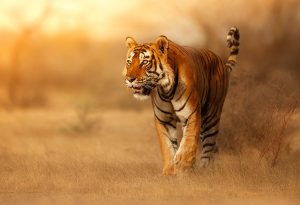
- Tigers can grow up to a length of 11 feet and weigh up to 300 kilograms when fully developed.
- Tigers belong to the cat family and are the biggest of their species.
- Tigers are excellent swimmers and are capable of swimming up to six kilometres at a stretch.
- Tigers are lone hunters and generally hunt at night, taking advantage of the dark.
- Tigers can reach a maximum speed of 65 km ph while chasing a meal for the family.
- Similarly, tigers can jump over 5 metres during hunts.
- The Royal Bengal Tiger, Siberian Tiger, Sumatran Tiger and Indochinese Tiger are various sub-species found in India, Malaysia, Bangladesh and North/South Korea.
- Tiger cubs stay with their mothers only till they reach the age of two years.
- Many subspecies of tigers have already become extinct or are endangered due to hunting and loss of forest cover due to civilization.
- Only 10% of tiger hunts turn out to be successful.
2. Dogs

- Dogs have been loyal and useful companions for humans through the ages, providing physical and emotional security as loving pets.
- There are about 400 million+ dogs in the entire world.
- Dogs are useful as they carry out farm work, provide security, hunting and even play guides to the visually-impaired. They are wonderful companions for children and the elderly due to their ability to give care and unflinching love.
- The most popular breeds of dog include Labrador, Golden Retriever, Bulldog, German Shepherd, Greyhound, St. Bernard, Great Dane, Chihuahua, etc.
- Due to the strong emotional connect dogs form with humans as pets, they are known as “man’s best friend”. They are extremely loyal and are known to spend their entire lifetime with their masters.
- Dogs have a terrific sense of hearing as compared to humans since they can hear sounds at four times the distance.
- The average life of a dog depending on the breed can vary from 10 to 14 years.
- Due to their amazing sense of smell, dogs are capable of differentiating and recognising odours. For this reason, they are used to sniff out drugs and weapons by anti-terrorist squads and police departments all over the world.
- Dogs are known to have been domesticated about 15000 years ago as per available scientific evidence.
- Domesticated dogs are omnivores as they can eat grains, vegetables and meat as a part of their diet.
3. Dolphin

- Dolphins are blessed with powerful eyesight and hearing which they use along with echolocation to find the right location of objects.
- Dolphins use whistling, clicking and other sounds to communicate with each other.
- The Killer Whale or Orca is actually a type of a dolphin.
- Male dolphins are called bulls, females as cows and young dolphins are known as calves.
- The most common type of dolphins found is Bottlenose dolphins.
- Dolphins have a blowhole located at the top of their heads which they use to breathe.
- A group of dolphins is known as a pod or a school which consist of a dozen of these intelligent animals.
- Dolphins are known to be extremely intelligent creatures and can interact with humans. They have a playful attitude which they display by riding waves and jumping in and out of the water, thus making them popular with kids and adults alike.
- Due to the use of nets, a large number of dolphins are killed every year and many species have become extinct.
- Dolphins are meat-eating (carnivores) mammals.
4. Elephants
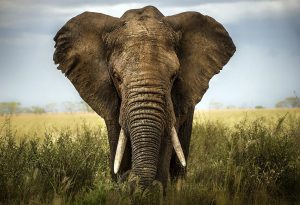
- Elephants are the world’s largest mammals living on land.
- The African Elephant and the Asian Elephant are the two types of elephants with Bush Elephant and Forest Elephant being sub-types of the African Elephant.
- The Elephant’s trunk is entirely made up of about 100,000 muscles and no bones. A full-grown elephant’s trunk can weigh about 140 kilograms and measure up to 2 metres.
- The elephant uses its trunk to know the size, shape and also to know if it is too hot or cold. It is used to suck in water or pick up food and put it into its mouth.
- An adult elephant needs to drink more than 200 litres of water every day and it uses its tusks to dig the earth for this purpose.
- The huge, thin ears of an elephant are made of blood vessels which help them to regulate their body temperature.
- Elephants use their trunks to breathe when they swim in deep waters.
- Elephants spend more than 16 hours every day uprooting twigs, leaves and roots for their nourishment.
- Male elephants leave their herds when they reach 13 years of age while females live in their herd for their entire lifetime.
- Female elephants remain pregnant for 22 months and begin to have calves when they are about 12 years old.
5. Giraffe

- A full-grown male giraffe can weigh up to 1400 kilograms
- The length of the giraffe’s long neck measures between 1.5 to 1.8 metres.
- A giraffe’s tail is made up of hair that is about 10 times thicker than the human hair.
- Horns are present on male and female giraffes, with males having up to three horns.
- The female giraffe delivers her baby while standing up and the baby falls about six feet without injuring itself.
- Male giraffes fight with their necks by swinging it from one side to another.
- The spots on a giraffe’s body act as camouflage for protection against predators.
- A giraffe has four stomachs which speed up the digestion process.
- Giraffes are most vulnerable while bending down to drink water since they cannot see an approaching predator.
- A giraffe’s tongue is coated with bristly hair which helps them to eat leaves from thorny trees like Acacia.
6. Lion
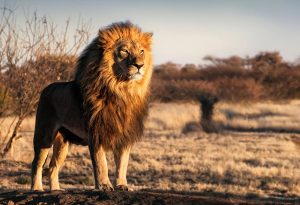
- A male lion weighs around 180 kilograms while an average female lion can weigh up to 130 kilograms.
- A lion’s roar is so powerful that can be heard from eight kilometres away.
- The heaviest lion ever weighed was at a mind-boggling 375 kilograms.
- The responsibility of hunting mostly lies with the female lion as they are better hunters than males.
- Lions are known to rest for around 20 hours a day.
- Males who possess darker manes are more likely to attract lionesses (female lions) for mating.
- Lions do not possess a lot of stamina due to which they can run only in short bursts.
- Countries like Singapore, Ethiopia, England, Bulgaria, the Netherlands and Albania have named the lion as their national animal.
- Lions have a lifespan of about 12 years.
- The breeding of lion and tigers gives birth to off-springs known as ligers and tigons.
7. Sharks

- A shark possesses an amazingly sharp sense of smell and can detect even a single drop of blood in the water.
- A shark’s skeleton is made up of cartilage which is tough and flexible tissues. There is not a single bone in their bodies.
- They possess powerful hearing too because of which they can hear a fish thrashing around even 500 metres away.
- Sharks have a set of smaller teeth behind the front teeth. The smaller teeth move forward and the front teeth then fall off.
- Sharks have to keep moving to get oxygen into their bloodstream as the water passes over the gills.
- Great whites can cut through the water at a speed of 30 km ph and are the deadliest of all.
- The whale shark can grow up to a massive length of 14 metres when fully developed.
- Some shark species lays eggs instead of living pups.
- A baby shark has to fend for itself right from birth as its own mother could eat it up.
- The great white has to eat large quantities of meat to keep its body temperature regulated.
8. Whales

- There are about 80 different species of whales with different shapes and sizes.
- Creatures like sea lice and barnacles stick to the whale’s skin and live there all their lives.
- Whales use a sing-song voice to call others and can sing a different tune too.
- Scientists use a wax plug in the whale’s ear that has a pattern on it, to determine its age.
- Most whales do not have teeth and use a comb-like fibre to filter tiny creatures from the water.
- Whale groups either consist of only male or only female whales and both almost never mix.
- The migration of whales from Northern and Southern hemisphere is timed such as to never meet each other in breeding areas.
- Though experienced, whales can lose their way during migration.
- A baby whale is known as a calf and is cared for by the entire group.
- The “smiling” face of a whale is due to the lower arched lip it possesses.
9. Camel
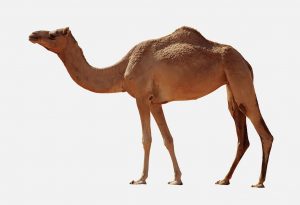
While providing desert animals information for kids, camels feature quite prominently in it.
- Camels have a life of 40 to 50 years.
- There are two types of camels i.e. dromedary (single-humped) and Bactrian (two-humped)
- Camels measure about 7 feet up to their hump and 6 feet up to their shoulders.
- Camels are a source of milk, wool and meat and are used for transportation or carrying heavy loads too.
- Camels have a thick coat on their body which insulates them from heat and extreme cold, making them suitable for deserts.
- Camels can survive up to six months without water or food due to the fatty tissues stored in their humps.
- The fatty tissues in a camel’s humps can be converted into energy or water as and when required.
- Camels can drink 113 litres of water within 13 minutes and are the fastest mammals to rehydrate.
- Camels have long legs which help them to stay above the hot desert surface.
- Dromedary camels weigh between 300 to 600 kg while Bactrian camels can weigh up to a maximum of 1000 kg too.
10. Cheetah
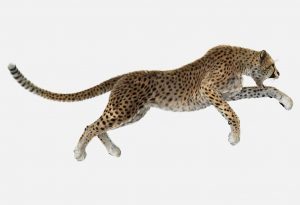
- The cheetah is the fastest animal to roam the earth with top speeds of 113 km per hour.
- A cheetah can go up to speeds from 0 to 113 km per hour in a matter of seconds.
- Though fast, cheetahs tire very quickly and need to rest before they burst into top gear again.
- Cheetahs weigh between 45-60 kilograms and are amongst the smallest members of the cat family.
- Cheetahs have great eyesight and are able to sight their prey from five kilometres away during the daytime.
- Cheetahs are the only members of the cat family unable to roar. However, they can purr quite loudly especially when they are in a group or during one of their grooming sessions.
- As opposed to other cat family members like lions and leopards who hunt at night, cheetahs are able to hunt only during the day.
- Cheetahs have blunt claws and a light body weight which makes them vulnerable to their enemies. It generally gives up if a larger animal confronts it during a fight or a hunt due to these physical restrictions.
- Cheetahs have a poor night vision which prevents hunting at night. They are also unable to climb trees due to their blunt claws and this gives them a distinct disadvantage during hunting.
- A cheetah is recognizable by the dark lines, known as tear lines that run from each eye towards the mouth. These tear lines protect the cheetah from the sun and give them a long-distance vision that’s necessary during hunting or protection from other predators.
These tear lines protect the cheetah from the sun and give them a long-distance vision that’s necessary during hunting or protection from other predators.
As a parent, you may want to teach your child about the abundant flora and fauna on our planet. You may also want to help your child develop a keen interest in the world around – how things work, how people react, and so on. Stories are a wonderful way to do this. Another way for you to ensure your child’s overall development is through subscription boxes designed for kids. Not only that, you can try DIY activities also to help your toddler to learn about and explore the world around, making him “intelligent” and aware even before he goes to the school!









